« July 2008 | Main | May 2008 »
Saturday 28 June 2008
The Frazier
I wanted to go to Frankfort today and see the Kentucky History Museum and Daniel Boone's Grave and the other famous Frankfort sites, but the weather forecast for the entire bluegrass area was for thunderstorms all day. So we visited the Frazier International History Museum, formerly known as the Frazier Historical Arms Museum, which is still a more accurate title, even if most of history is defined by arms and war.
We started with a re-enactment (they do a lot of re-enactments there) of a slave, Olauduh Equiano, telling of his life in the mid-eighteenth century. He had managed to eventually earn his freedom and write his memoirs, which were a best seller of the day, making him rather wealthy, and giving us a glimpse into the experiences of an American slave.
Following that, we saw an exhibit on the Tower of London; how and why it was created and how it evolved over hundreds of years. CVH says she didn't get to see it when she visited London, as it is the most popular attraction there and you have to wait in line for hours. Based on what I saw in the Frazier exhibit, I can believe that; it looks like an absolutiely fascinating place, and the Frazier gives you a tasty morsel of it. Then there was an expansive exhibit of European arms from the Medieval through nineteenth century period: items like chain mail, body armour, and an exhibit on the Battle of Hastings. This pivotal battle of the Norman conquest of England, and particularly the Bayeux Tapestry, has fascinated me since I learned about it as a small boy during its nine hundredth anniversary. The motivations for war then were pretty much the same as always: control of land and resources, and domination of the people who might take these away from you, but the nature of the warfare was a bit different from what we see today. It was hand to hand combat, and the goal was not particularly to kill your opponent, but to just disable him enough so that he was no longer able to fight: a blow to the thigh or gut that would cause him to drop and eventually bleed to death was the typical objective.
After reflecting upon these cheery events, we watched another re-enactment about the life of Julie D'Aubigny, aka "La Maupin". She was an opera singer and swordswoman who became quite well known in France during the reign of the Sun King. Her father was disappointed when she was born a girl instead of a boy, and tried to make the best of it by instructing her in the various masculine arts, including fencing. At fourteen she became the mistress of the influential Count d'Armagnac. She went on to have a variety of husbands and lovers (not all of them male), fought duels and eventually had an opera career, thanks to her contralto voice, which was otherwise only available to opera companies via castrati.
I found it a great story, but CVH dismissed it with "The French." Then we went to this summer's special exhibition, Survivor Jamestown. This is aimed a lot at kids, but if you take the time to read everything there, you will learn something about Jamestown and how hard it was that first year. You play either one of the gentlemen or one of the laborers that went to Jamestown in 1607. Only 38 of the 104 who landed survived the first year, so your odds aren't so hot to start with, but you come in armed with more knowledge (maybe) than they did. You're given a certain number of points in various categories to start with, and those points go up and down depending on decisions that you make and your luck. When winter came, I was doing quite well as a successful gentleman. I was well-fed, healthy and quite wealthy (I had traded well with the natives). Even when the first resupply ship showed up with too many new people and not enough food, I was still doing fine. But then three days later the food warehouse burned to the ground and I was so dispirited that I lost the will to live and expired. My heirs were well taken care of, though. CVH's character of a common laborer was doing pretty good too, but a week after my death he was crossing the river when the canoe capsized and he drovned (this was before YMCAs were common, I suppose).
Finally we saw another reenactment by a Pinkerton man who described the first train robbery. This occurred in Seymour, Indiana in 1866. I missed the part specific to the train robbery, but did hear how the authorities of the time were having problems with a large group of Louisvillians. Seems that these good folks were mad as hell with the various brigands and highwaymen of the time, and they weren't going to take it anymore. So the police had a tough time transporting the men they had arrested to trial: they'd often be ambushed by large groups of men wearing red bandannas oaver their faces, who would take the captives and hang them from the nearest tree.
Kids will love the place.
It didn't rain a drop all day.
Tuesday 17 June 2008
The $79 cucumber
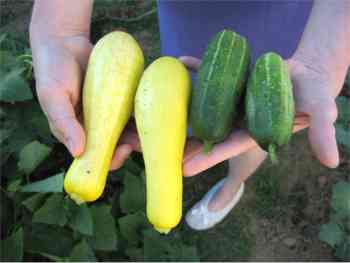 Our little garden has been a lot of work for such a small garden. At
least two hours a week, and I'm not keeping ahead of the weeds and
insects by any means. And up until today, my five hundred dollar or so
investment had yielded some herbs, a couple of arugula salads and two
green onions (but they were really good green onions). Then
today, we had our first vegetable harvest: two cucumbers and two yellow
squash.
Our little garden has been a lot of work for such a small garden. At
least two hours a week, and I'm not keeping ahead of the weeds and
insects by any means. And up until today, my five hundred dollar or so
investment had yielded some herbs, a couple of arugula salads and two
green onions (but they were really good green onions). Then
today, we had our first vegetable harvest: two cucumbers and two yellow
squash.
Sunday 15 June 2008
A bloody revolution comes to Louisville
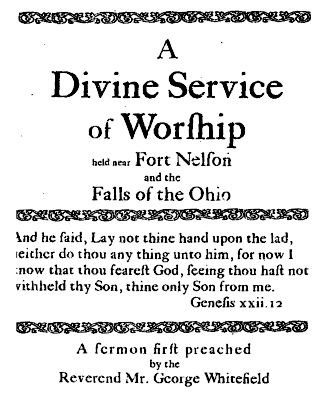 We returned to Riverside, the historical trading site on the Ohio River
that we visited last month, for their "100 Years On The Ohio - A Living
Timeline of Louisville's First Century (1765 through 1865)", and it was so
cool! There were dozens of re-enactors there covering the period
from Daniel Boone to the War Between the States. It started out with a
church service based on a Revolutionary War period sermon.
We returned to Riverside, the historical trading site on the Ohio River
that we visited last month, for their "100 Years On The Ohio - A Living
Timeline of Louisville's First Century (1765 through 1865)", and it was so
cool! There were dozens of re-enactors there covering the period
from Daniel Boone to the War Between the States. It started out with a
church service based on a Revolutionary War period sermon.
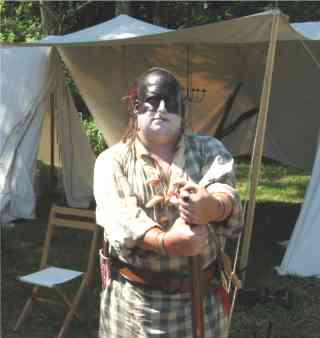
One very scary Indian
After that, we went back to the visitor center where a local re-enactor, Mandy Dick, discussed her experiences as a re-enactor and her suggestions for enhancing one's effectiveness as one. Then there was the "fashion show" where several of the ladies and gentlemen from various points on the timeline got up and displayed the costumes and uniforms that they had worked so diligently on. We learned that clothes during the late seventeen hundreds were made very small along the back so as to pull the shoulders back and, along with curved sleeves, force an upright posture on their wearer. The tri-corner hat turns out to have been strictly a fashion item: it didn't keep the sun out of your eyes, or the rain off you, and when you raised your rifle to shoot, it tended to bang into the hat.
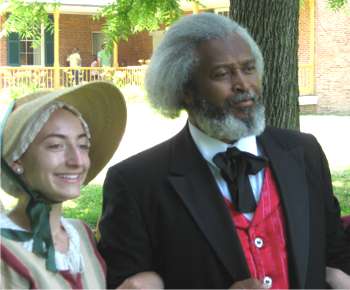 Following the discussions about fashions two hundred years ago a couple
of re-enactors from Nashville arrived and portrayed Abraham Lincoln and
Frederick Douglass. They dramatized a discussion that the two had in the
Oval Office about how black Union soldiers were being treated. The show
lasted nearly an hour, and these guys were really good, especially the
fellow playing Douglass, who didn't come out of character even after the
performance was complete. I'm not sure how much of their dialogue was
their own invention, and how much was from contemporary accounts, but
they were certainly convincing and mesmerizing in their characters.
Following the discussions about fashions two hundred years ago a couple
of re-enactors from Nashville arrived and portrayed Abraham Lincoln and
Frederick Douglass. They dramatized a discussion that the two had in the
Oval Office about how black Union soldiers were being treated. The show
lasted nearly an hour, and these guys were really good, especially the
fellow playing Douglass, who didn't come out of character even after the
performance was complete. I'm not sure how much of their dialogue was
their own invention, and how much was from contemporary accounts, but
they were certainly convincing and mesmerizing in their characters.
By that time we were hungry and ducked down the road to Mike Linnig's again for some fried catfish. We returned to Riverside to browse the vendor markets, watch the blacksmith (working without eye protection, a level of authenticity that I would not have been at all comfortable with), and then it was time for the skirmish between the Rebels and Brant's guerrillas The guerrillas took up hiding places under trees both down by the river as well as uphill, so as to give them a good crossfire location. Then the Rebel (Patriot) regulars came through with their drummer boys and fife players and surrounded the mansion on the property, where they captured two of the white men that we had seen earlier in the day at Brant's camp. They came marching through the field with their captives, past the guerrillas and when they were about fifty yards past Brant, Brant and his men opened fire at their backs. The Rebels (in formation) slowly turned to face the assault and started shooting back. At that distance, no damage was done. After several minutes of flintlock rifles reporting back and forth, the Rebel officer pulled out his white handkerchief and, waving it, marched toward Brant's location up the in trees. Brant came out into the open, and demanded the return of his two men. The Rebel officer replied that they were spies, and should be hanged. Brant then motioned to his second, who produced the three white women who (I guess ) were captured during the battle the day before. They were tied together with rope. Brant said that he would trade two of the women for his two men, but that he wanted to keep one of them (the one who could sew and cook, I assume). The Patriot officer refused the offer and Brant acquiesced to giving up all three. While the prisoners taunted their captors, the Rebel officer and Brant retreated to their positions and proceeded to release their respective captives. The two Brant walked back toward their allies, and the three women walked toward the Rebel men.
Then just as the two groups pass each other, one of the Loyalist men grabbed one of the women, produced a knife, slit her throat, and she fell like a rock. The two former prisoners started running back toward Brant, while another of Brant's Indians leapt out of a hiding spot and killed and scalped the other two women before the Patriot men had a chance to react. It all happened so quickly, and so unexpectedly, that it took me a moment to realize what these people, who seemed so personable earlier in the day, had actually done. I'm assuming that this was based on an actual incident, but there were a lot of children in the audience, and this was at least PG-13! The battle went on, the soldiers stepping over the bodies of the women as necessary, as they fired back and forth, the Patriots finally routing Brant's guerrillas. A sobering reminder that some things about war haven't changed much in the last two hundred and twenty five years.
Saturday 14 June 2008
Stuff to do in Lousiville
No single theme for today; just elements of entertainments in our town.
We started out at the Callahan Museum where we saw, among other things, a video about Denver the Dog Guide (you will find a picture of Denver and his owner elsewhere in this blog). The video is a real tear-jerker; we both wished they had provided Kleenex for us. There was also a good description of the "War of the Dots". You see, for many years in the late nineteeth and early twentieth centuries, there was a ongoing battle between two raised-dot codes that were used to produce publications for the blind (at one time, there were six popular codes, and a well-read blind person would have to know all of them). One of the codes was called New York Point and the other Braille. Obviously I don't have to tell you which won the battle, but the museum exhibit boiled down the pros and cons of both systems: New York Point produced smaller books, which were less expensive to produce and purchase, so publishers and school boards tended to favor them. However, compared to Braille, New York Point tended to render text without important punctuation (including capitals), so the blind tended to prefer Braille. The more comprehensive and accurate Braille carried the day, although incredibly, the controversy was not settled until the nineteen-thirties, and even then, there were differences between American and British Braille that continued to confound publishers and readers.
By the time we got through with the exhibit, we were hungry, and headed down the street to the Belvedere, where the Greek Festival was going on (we went there last year). It's not really much of a "festival" but rather a great meal at a very reasonable price. Get there early or you might face a long wait in line. Then we visited the formal gardens at the Presbyterian Seminary. The Presbyterian Church of the USA is headquartered in Louisville, and the campus is very pretty, right the on the edge of Cherokee Park, and includes some elements that were also designed by the Olmstead firm.
Later we headed to the mall where we effectively spent our economic stimulus check, which we have yet to receive. We have hundreds of cassette tapes that are deteriorating, I am sure, and we'd like to save the music on them (many are live recordings and essentially irreplaceable). So I bought a device that plays the cassettes into MP3 files, but it uses the Apple iTunes software, which I guess is obvious to Apple users, but doesn't follow the Microsoft paradigm much at all and I'm having a difficult time figuring out how to get it to work. I may have to ask one of the younger people at work how to do it.
Saturday 07 June 2008
Charlestown Herb & Garden Festival
This year we again went to the Sunnyside Master Gardener Association's Herb & Garden Festival in Charlestown, Indiana. It was a recession-year festival; scaled back from last year's; it costs a lot of money to load up a truck and haul your goods to Charlestown. The ladies still crank out a wonderful herbal luncheon for seven dollars, though. We also bought several gardening books and a lantana plant (note to our Houston friends: did you know that lantana is considered an annual? I had lantanas the size of Volkswagens in Houston. We'll see how long I can make this one last - the nurseries sell banana plants here, so some people must be working on a system).
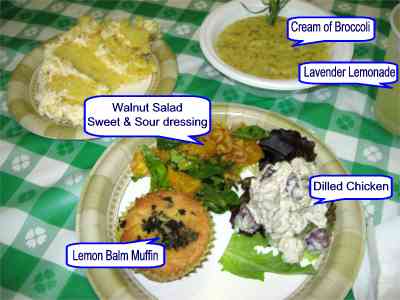
See Rock City
After the Herb & Garden festival, we paid a visit to the berry farm that we went to last year (see archives: 02 June 2007). This year the weather has been much better, and they had tiny, delicious, juicy strawberries for sale - not those huge, dry wooden ones you get at Kroger. The blueberries were not quite ready, alas. We then headed to Clifty Falls State Park. I wrote back in April that Brown County State Park is "the jewel of Indiana's park system", and while that may be true, Clifty Falls must be the gold nugget in their pocket. Not as large as Brown County, it is an amazing park: CVH and I agreed that it is the cliftiest park either of us had ever been to. The story is that millions of years ago Clifty Creek plunged into the Ohio River in a waterfall hundreds of feet high (of course, no one knows for sure), and since then erosion has backed up the creek over two miles into a series of falls in the park. The retreat continues at a rate of one-quarter inch a year.
We began our visit at the nature center, where a park ranger gave a talk on box turtles. Did you know that June is Box Turtle Awareness month? Box turtles are now protected in Indiana due to their dwindling numbers (they can live to be a hundred years old, but cars run over too many of them). If you see a turtle trying to cross the road, you're allowed to pick them up and help them on their way, as long as you point them in the direction that they were going when you found them (otherwise they'll just turn around on you).
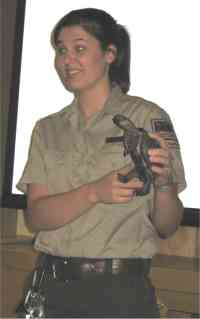
Bob, the box turtle
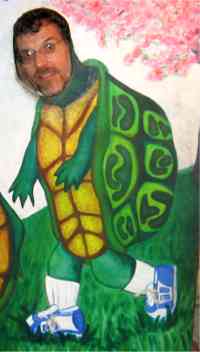
Conrad as a turtle
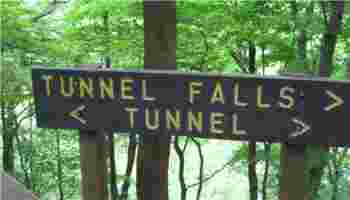 As we were driving into the park, I remarked to CVH on the
incredible steepness of the hills in the park. "It seems that the trees
would just slide down the hills here," I said. And sure enough, the
first couple of trails that we went on had major sections closed due to
landslides. But later we were able to get close to the creek and several
of the falls. Back in the 1850's, a railroad company tried to build a
railway through the park. The effort ended in bankruptcy, but left
extensive grade work which is the basis for many of today's trails, and
most notably, a six-hundred
foot tunnel, which CVH had no desire whatsoever to enter. But
we still enjoyed the view of the Tunnel Falls.
As we were driving into the park, I remarked to CVH on the
incredible steepness of the hills in the park. "It seems that the trees
would just slide down the hills here," I said. And sure enough, the
first couple of trails that we went on had major sections closed due to
landslides. But later we were able to get close to the creek and several
of the falls. Back in the 1850's, a railroad company tried to build a
railway through the park. The effort ended in bankruptcy, but left
extensive grade work which is the basis for many of today's trails, and
most notably, a six-hundred
foot tunnel, which CVH had no desire whatsoever to enter. But
we still enjoyed the view of the Tunnel Falls.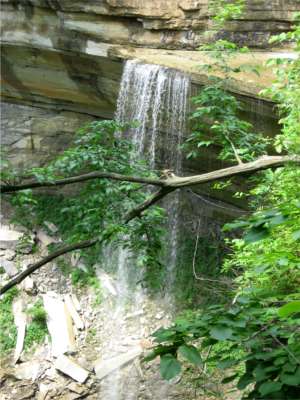
Then it was more hiking around to see the Big Clifty and Little Clifty Falls. Although many of the trails at the park are very steep and rugged, and we were not prepared to hike them, I was very impressed at how they had made so much of the park accessible. Excellent views (or the sounds) of the Big Clifty Falls were available to almost every person. A great park for hikers of all abilities.
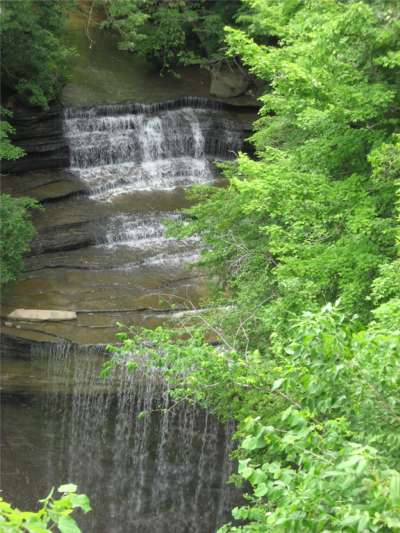
Big Clifty Falls
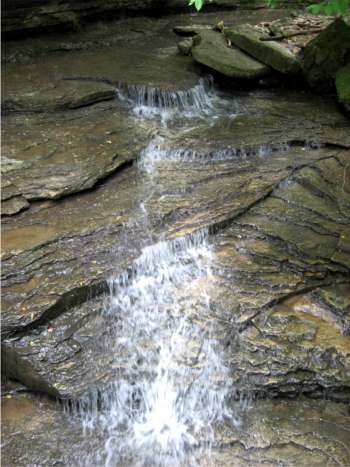
Little Clifty Falls
Sunday 01 June 2008
Okra
CVH, being a Southern type of gal, has been hankering for fresh okra for some time now. The okra that is showing up at Kroger has just been too old, she says; it's tough. But finding okra seedlings for our garden has been fruitless so far.
 The Kentucky Farm Bureau has a program to promote its members' products:
the certified
roadside farm market program. They distribute a map with all the
locations, and we decided to try a couple today. We lucked out at Tower
View Farm and Nursery; they had little okra seedlings just begging for a
good home.
The Kentucky Farm Bureau has a program to promote its members' products:
the certified
roadside farm market program. They distribute a map with all the
locations, and we decided to try a couple today. We lucked out at Tower
View Farm and Nursery; they had little okra seedlings just begging for a
good home.
That task finally fulfilled, we decided to head down the road just a little bit to Lake Taylorsville State Park. It's outside the small town of Taylorsville; you take Taylorsville road to get there. There's a lot of that in Louisville: Bardstown Road will take you to Bardstown, the George Rogers Clark bridge will take you to Clarksville, Frankfort Avenue will take you to Frankfort, but first it goes to Shelbyville, so it changes its name to Shelbyville Road.
Anyway, we get there and discover that it's one of those big projects from the Army Corps of Engineers' heyday. A massive earth dam with a bunch of boats on one side and fishermen on the other. They have an hilltop outlook where you can look at the dam, visit the history site, and walk a short trail. We looked at the dam, and started down the trail where a large snake was spotted. That was the end of the trail walk for CVH, so we visited the historical site. Archaeological digs show that people have been living in the area for at least ten thousand years (yes, Kentucky is that nice a place; just ask Daniel Boone: "Not a breeze shook the most tremulous leaf. I had gained the summit of a commanding ridge, and, looking round with astonishing delight, beheld the ample plains, the beauteous tracts below."). The history site is built where a family farm had been for 150 years until the Corps booted them off to make the lake.
However, if you don't have a boat and/or fishing pole, there's not a whole lot to do at the park on a hot summer's day. You can listen to the cicadas, which are very loud this year.